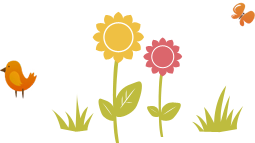Toilet Learning Procedure
Toilet learning should be a positive experience for everyone involved. The key to success is 1) waiting until the child is ready and 2) having close communication with the family. Prior to beginning the process of learning to use the toilet, we require a meeting between the family and classroom teachers to go over expectations.
If you are currently considering potty training your child, take this quiz – TRUE or FALSE:
- Stays dry for at least 2 hours at a time, or after naps
- Recognizes that she is urinating or having a bowel movement. For example, your child might go into another room or under the table when she has a bowel movement. This is important—if you child does not realize she is having a bowel movement, she will not be successful at potty training.
- Is developing physical skills that are critical to potty training—the ability to walk, to pull pants up and down, and to get onto/off the potty (with adult help).
- Copies a parent’s toileting behavior.
- Can follow simple instructions.
- Most important, your child wants to use the potty. He can tell you that he wants to wear “big boy” underpants or learn to go potty “like Daddy does.” He may feel uncomfortable in a soiled diaper. Your child asks to change their diaper or asks to use the restroom himself.
Once we agree on the stages and signs that your child is ready to use the toilet, parents will initiate training at home over a weekend. It is important that parents be the one to start this process and not the childcare provider. A consistent routine and follow through at home will help your child more successfully learn to use the toilet.
If at this point you feel your child is ready; let the teacher know to continue the process at school. We will collaborate with you on toilet training your child for 10 (ten) working days. If your child shows no interest, too many fears, or too many accidents, we will discontinue training until we feel s/he is ready to start again.
We highly discourage the use of pull ups when teaching a child to use the toilet. One of the first signs that we use to tell us that a child is ready to be potty trained is when they really do not like the mussy feeling of a wet diaper. Pull ups are like a disposable diaper and do not allow the child to feel wet. When a child does not feel wet, they have no reason to use the toilet. Pull ups often prolong the process of learning because of this. Additionally, pull ups often cost more money than diapers. You will save more money by doing extra loads of laundry than purchasing pull ups during the process. Always keep multiple (5 or more) full sets of extra clothing in your child’s cubby (pants, shirts, underwear, socks, and shoes).
There is no right age by which all children should be toilet trained. Toilet training is an individual and rewarding as learning to walk. We do not use any reward system as part of our toilet learning process at Wishing Well.
Wishing Well Preschool will be closely coordinating with the child’s family, using terminology and procedures that are as consistent as possible at home and at the center. Expect your child to have accidents and will never be cause for punishment or humiliation.
Due to state health regulations, staff are not able to wash out soiled clothes however, the teacher will discard feces if possible. Soiled items will go into a plastic bag to take home. We do not use small plastic potties for children who are toilet learning. We do have small inserts for our regular toilets with step stools. A teacher will accompany each child in the bathroom. To help in the process; please dress your child in loose fitting clothes for them to pull up and down.
Books for children:
Going to the Potty, by Fred Rogers
Once Upon a Potty, by Alona Frankel
Koko Bear’s New Potty, by Vicki Lansky
Let’s Go to the Potty: A Potty Training Book for Toddlers, by Allison Jandu
Toilet Training Orientation
Toilet learning should be a positive experience for a child. It should take only a brief period if the child is ready. Toilet learning is as individual as learning to walk. There is no right age by which all children should be using the toilet. Problems in toilet learning usually arise because adults do not pay attention to the child’s lack of readiness.
We will try toilet learning with your child for 10 days. If the child shows no interest, is fearful, or has too many accidents your child will go back into diapers until we decide together that your child is ready to try again.
We are listing eight helpful hints of ways we can work together to minimize frustration and maximize success. Of course, encourage your child, and continue the process at home.





